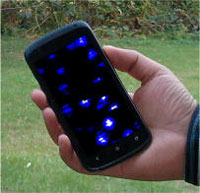| Oct 11, 2013 | |
Toward single-molecule microscopy and spectroscopy on smartphones |
|
| (Nanowerk News) Thanks to fluorescence, single nano-objects down to individual fluorophores can now be imaged in optical microscopes. Fluorescence imaging is still restricted to laboratory facilities as it usually involves expensive and bulky instrumentation. A recent report ("Using a smartphone to detect single nanoparticles and viruses"), however, shows that a sensitive, cost-effective, and portable device can be developed to image individual nano-objects as small as large viruses. | |
 This work opens the fascinating prospects of single-molecule microscopy and spectroscopy on a smartphone. In a Perspective article in ACS Nano ("Toward Single-Molecule Microscopy on a Smart Phone"), Prof Michel Orrit and postdoc researcher Saumya Khatua from the University of Leiden, speculate on the possible applications of such a portable imaging device and on the perspectives it may open in different fields of science and technology. "Detecting single molecules in the field in remote areas, far from any scientific laboratory, would open a wide range of potential applications, many of which we can only dream today," they write. "Think, for example, of the detection of allergens with labeled antibodies or of imaging short DNA strands through their complementary sequences, with hybridization leading to a fluorescence resonance energy transfer (FRET) signal. "Their detection in the field and in real time would revolutionize pollution monitoring, forensics, the authentication of products, and a myriad of other uses. 'Democratized' single-molecule detection would be primarily appealing for epidemiologic purposes. Low-priced alternatives to expensive analysis techniques would make it possible to follow the propagation of pathogens through parallel monitoring by many observers, even before the first symptoms of an infectious disease manifest themselves. |
|
| "Decentralized single-molecule observations would replace the strength of having a few high-end laboratories by the massive acquisition and parallel use of (probably) lower quality, but statistically more reliable observations. | |
| "Even more importantly, because the requirements of purification, sterilization, and shipping would be relinquished to a large extent, this massive monitoring could occur, if not instantaneously, at least on a much shortened time scale than today. The same technical progress would apply not only to molecules, but to a broad range of other emitters, including gold nanoparticles, semiconductor quantum dots,9 rare-earth-doped nanoparticles, or nanodiamonds." | |
| They also point to spectrally resolved microscopy as another attracive direction opened by cell-phone-borne devices. "Spectral resolution of fluorescence creates many multiplexing possibilities in the detection of particles or molecules, which would enrich the above possibilities. Moreover, spectral resolution also opens the coupling of microscopy with Raman spectrometry, thus allowing quantitative chemical analysis in situ." |
| Source: American Chemical Society |
